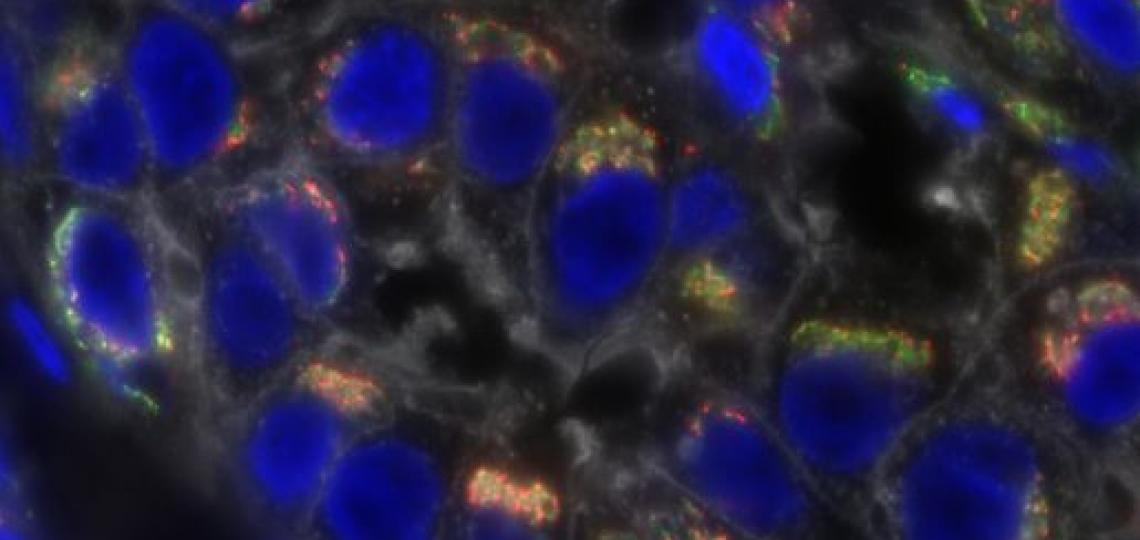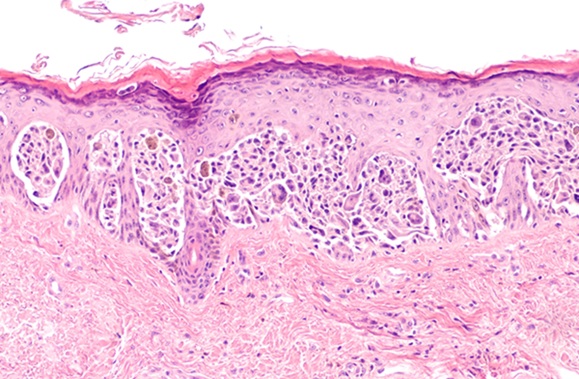Gene Deletion Underlies Resistance to Chemotherapy in Triple-Negative Breast Cancer
|
By LabMedica International staff writers Posted on 29 Aug 2022 |

A proteognomics approach was used to identify biomarkers in samples from triple negative breast cancer (TNBC) patients that were associated with resistance to chemotherapy treatment.
Proteogenomics is a field of biological research that utilizes a combination of proteomics, genomics, and transcriptomics to aid in the discovery and identification of peptides. Proteogenomics is used to identify new peptides by comparing MS/MS spectra against a protein database that has been derived from genomic and transcriptomic information.
Triple-negative breast cancer (TNBC) is a type of breast cancer that lacks or shows low levels of estrogen receptor (ER), progesterone receptor (PR), and human epidermal growth factor receptor 2 (HER2) overexpression and/or gene amplification. TNBC comprises 15–20% of all breast cancer cases and affects more young women or women with a mutation in the BRCA1 gene than other breast cancers. Triple-negative breast cancers, which comprise a very heterogeneous group of cancers, are the most challenging breast cancer type to treat, as hormone therapy that is used for other breast cancers does not work for TNBC.
In its early stages, TNBC is typically treated through surgery, radiation, and chemotherapy. In later stages where surgery is not possible or the cancer has spread from the initial localized area, treatment is limited to chemotherapy and in some cases further targeted therapy. Triple-negative breast cancers have a relapse pattern that is very different from hormone-positive breast cancers where the risk of relapse is much higher for the first three to five years, but drops sharply and substantially below that of hormone-positive breast cancers afterwards.
In order to predict response to treatment, investigators at Baylor Medical College (Houston, TX, USA;) and their colleagues used an innovative analytic approach called “microscaled proteogenomics” to analyze tumor biopsies taken from TNBC patients prior to treatment with carboplatin and docetaxel combination chemotherapy. Data from standard DNA and RNA sequencing approaches were integrated with mass spectrometry-based proteomics and phosphoproteomic analyses to derive more complete molecular portraits of treatment-responsive versus treatment-resistant tumors.
Results of proteogenomic analyses of somatic copy number aberrations identified a resistance-associated 19q13.31-33 deletion where the genes LIG1, POLD1, and XRCC1 are located. LIG1 (DNA ligase I) gene deletion and/or low mRNA expression levels were associated with lack of pathological complete response, higher chromosomal instability (CIN), and poor prognosis in TNBC, as well as carboplatin-selective resistance in TNBC pre-clinical models. Hemizygous loss of LIG1 was also associated with higher CIN and poor prognosis in other cancer types, demonstrating broader clinical implications.
“TNBC is the most difficult to treat form of breast cancer, with standard treatment requiring multiple chemotherapy drugs that unfortunately often fail to cure the patient,” said first author Dr. Meenakshi Anurag, assistant professor of medicine at Baylor Medical College. “It is imperative that we develop approaches to predict response so that only effective treatments are given. Furthermore, patients who do not respond to standard drugs need entirely new treatment approaches. The discovery of therapeutic alternatives will depend on new insights into how TNBC arises.”
The study was published in the August 24, 2022, online edition of the journal Cancer Discovery.
Latest Molecular Diagnostics News
- New Biomarker Panel to Improve Heart Failure Diagnosis in Women
- Dual Blood Biomarkers Improve ALS Diagnostic Accuracy
- Automated Test Distinguishes Dengue from Acute Fever-Causing Illnesses In 18 Minutes
- High-Sensitivity Troponin I Assay Aids in Diagnosis of Myocardial Infarction
- Fast Low-Cost Alzheimer’s Tests Could Detect Disease in Early and Silent Stages
- Further Investigation of FISH-Negative Tests for Renal Cell Carcinoma Improves Diagnostic Accuracy
- First Direct Measurement of Dementia-Linked Proteins to Enable Early Alzheimer’s Detection
- New Diagnostic Method Detects Pneumonia at POC in Low-Resource Settings
- Blood Immune Cell Analysis Detects Parkinson’s Before Symptoms Appear
- New Diagnostic Marker for Ovarian Cancer to Enable Early Disease Detection

- Urine Test Detects Early Stage Pancreatic Cancer
- Genomic Test Could Reduce Lymph Node Biopsy Surgery in Melanoma Patients
- Urine Test Could Replace Painful Kidney Biopsies for Lupus Patients
- Blood Test Guides Post-Surgical Immunotherapy for Muscle-Invasive Bladder Cancer
- Mitochondrial DNA Mutations from Kidney Stressors Could Predict Future Organ Decline
- Blood Test Could Predict Bariatric Surgery Outcomes in Teenagers
Channels
Clinical Chemistry
view channel
VOCs Show Promise for Early Multi-Cancer Detection
Early cancer detection is critical to improving survival rates, but most current screening methods focus on individual cancer types and often involve invasive procedures. This makes it difficult to identify... Read more
Portable Raman Spectroscopy Offers Cost-Effective Kidney Disease Diagnosis at POC
Kidney disease is typically diagnosed through blood or urine tests, often when patients present with symptoms such as blood in urine, shortness of breath, or weight loss. While these tests are common,... Read moreHematology
view channel
ADLM’s New Coagulation Testing Guidance to Improve Care for Patients on Blood Thinners
Direct oral anticoagulants (DOACs) are one of the most common types of blood thinners. Patients take them to prevent a host of complications that could arise from blood clotting, including stroke, deep... Read more
Viscoelastic Testing Could Improve Treatment of Maternal Hemorrhage
Postpartum hemorrhage, severe bleeding after childbirth, remains one of the leading causes of maternal mortality worldwide, yet many of these deaths are preventable. Standard care can be hindered by delays... Read more
Pioneering Model Measures Radiation Exposure in Blood for Precise Cancer Treatments
Scientists have long focused on protecting organs near tumors during radiotherapy, but blood — a vital, circulating tissue — has largely been excluded from dose calculations. Each blood cell passing through... Read moreImmunology
view channel
Chip Captures Cancer Cells from Blood to Help Select Right Breast Cancer Treatment
Ductal carcinoma in situ (DCIS) accounts for about a quarter of all breast cancer cases and generally carries a good prognosis. This non-invasive form of the disease may or may not become life-threatening.... Read more
Blood-Based Liquid Biopsy Model Analyzes Immunotherapy Effectiveness
Immunotherapy has revolutionized cancer care by harnessing the immune system to fight tumors, yet predicting who will benefit remains a major challenge. Many patients undergo costly and taxing treatment... Read moreMicrobiology
view channel
15-Minute Blood Test Diagnoses Life-Threatening Infections in Children
Distinguishing minor childhood illnesses from potentially life-threatening infections such as sepsis or meningitis remains a major challenge in emergency care. Traditional tests can take hours, leaving... Read more
High-Throughput Enteric Panels Detect Multiple GI Bacterial Infections from Single Stool Swab Sample
Gastrointestinal (GI) infections are among the most common causes of illness worldwide, leading to over 1.7 million deaths annually and placing a heavy burden on healthcare systems. Conventional diagnostic... Read morePathology
view channel
AI Tool Improves Accuracy of Skin Cancer Detection
Diagnosing melanoma accurately in people with darker skin remains a longstanding challenge. Many existing artificial intelligence (AI) tools detect skin cancer more reliably in lighter skin tones, often... Read more
Highly Sensitive Imaging Technique Detects Myelin Damage
Damage to myelin—the insulating layer that helps brain cells function efficiently—is a hallmark of many neurodegenerative diseases, age-related decline, and traumatic injuries. However, studying this damage... Read moreTechnology
view channel
AI Model Achieves Breakthrough Accuracy in Ovarian Cancer Detection
Early diagnosis of ovarian cancer remains one of the toughest challenges in women’s health. Traditional tools such as the Risk of Ovarian Malignancy Algorithm (ROMA) can struggle to distinguish between... Read more
Portable Biosensor Diagnoses Psychiatric Disorders Using Saliva Samples
Early diagnosis of psychiatric disorders such as depression, schizophrenia, and bipolar disorder remains one of medicine’s most pressing challenges. Current diagnostic methods rely heavily on clinical... Read more
Cell-Sorting Device Uses Electromagnetic Levitation to Precisely Direct Cell Movement
Sorting different cell types—such as cancerous versus healthy or live versus dead cells—is a critical task in biology and medicine. However, conventional methods often require labeling, chemical exposure,... Read moreIndustry
view channel
Co-Diagnostics Forms New Business Unit to Develop AI-Powered Diagnostics
Co-Diagnostics, Inc. (Salt Lake City, UT, USA) has formed a new artificial intelligence (AI) business unit to integrate the company's existing and planned AI applications into its Co-Dx Primer Ai platform.... Read more























